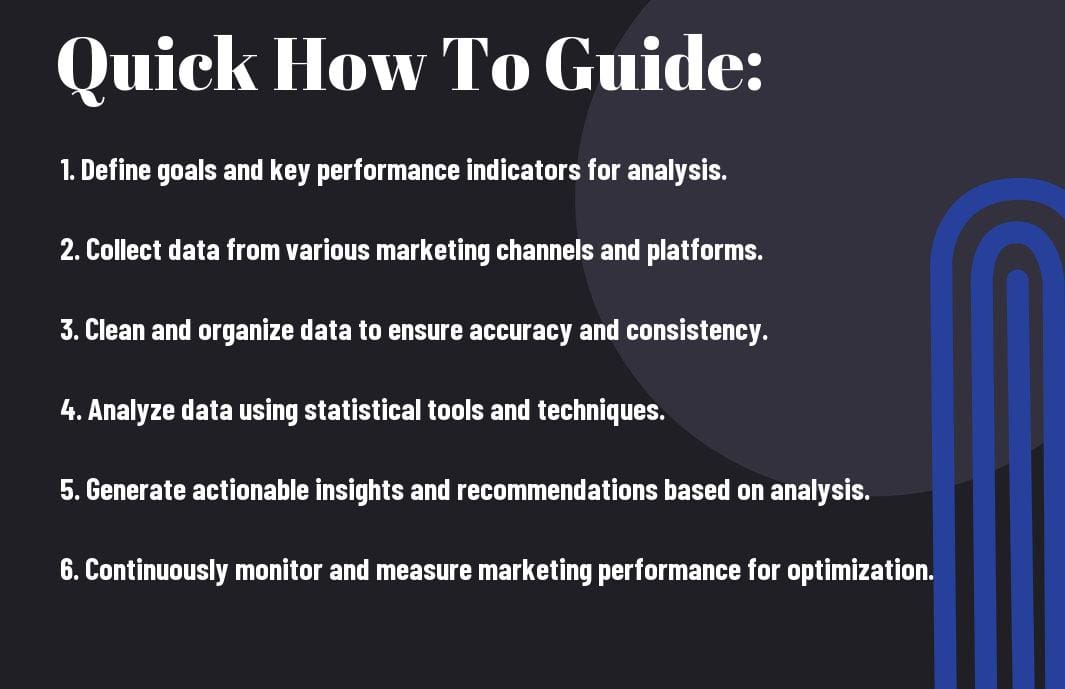Marketing analytics is a crucial component of any successful marketing strategy. Understanding how to leverage data to make informed decisions can drastically improve the effectiveness of your campaigns. In this how-to guide, we will break down the key steps for beginners to master marketing analytics and drive impactful results for your business.
Key Takeaways:
- Understand the importance of data: Data is crucial in marketing analytics as it provides insights into customer behavior, preferences, and trends.
- Utilize the right tools: Use marketing analytics tools such as Google Analytics, Adobe Analytics, or HubSpot to analyze data and track the effectiveness of marketing campaigns.
- Measure and adjust strategies: Continuously monitor key performance indicators (KPIs) to evaluate the success of marketing efforts and make data-driven decisions to optimize strategies.

Getting Started with Marketing Analytics
One of the first steps to mastering marketing analytics is to understand the key concepts and metrics that drive insights and decisions.
Understanding Key Marketing Metrics
Any beginner in marketing analytics should familiarize themselves with vital metrics such as ROI (Return on Investment), CTR (Click-Through Rate), CPA (Cost Per Acquisition), and Customer Lifetime Value. These metrics provide crucial information about the effectiveness of marketing campaigns, customer behavior, and overall business performance. By understanding and tracking these metrics, you can make informed decisions to optimize your marketing strategies and improve results.
Setting Up Your Analytics Tools and Platforms
Clearly, setting up the right analytics tools and platforms is vital for collecting, analyzing, and interpreting data effectively. Tools like Google Analytics, HubSpot, and Adobe Analytics can help you track website traffic, user engagement, and campaign performance. It is crucial to configure these tools correctly and integrate them with your marketing channels to get a comprehensive view of your digital marketing efforts.
Another important aspect of setting up your analytics tools and platforms is ensuring data accuracy and consistency. Any discrepancies or errors in data collection can lead to misinterpretation and skewed results. It is crucial to regularly audit your analytics setup and invest in proper training to utilize these tools to their full potential.
How-To: Collecting the Right Data
Once again, if you are delving into the world of marketing analytics, you may want to check out Marketing Analytics Mastery: From Strategy to Application. Understanding the intricacies of data collection is crucial for making informed decisions that drive your marketing efforts.
Identifying Your Data Sources
Even before you begin collecting data, it’s imperative to identify the sources that will provide you with relevant and valuable information. These sources can include your website analytics, social media platforms, email marketing tools, customer relationship management (CRM) systems, and more. By pinpointing these sources, you can streamline your data collection process and ensure that you are focusing on the most important metrics for your business goals.
Tips for Effective Data Collection
- Define Your Objectives: Before you start collecting data, clearly outline your marketing objectives and the key performance indicators (KPIs) that align with them. This will guide your data collection efforts and help you avoid collecting irrelevant data.
- Utilize Automation: Leverage tools and software that automate data collection processes to save time and minimize errors. Automation can help you gather real-time data across multiple platforms efficiently.
Data collection is the foundation of marketing analytics, and it’s crucial to get it right from the start. Assume that inaccurate or incomplete data can lead to misguided decisions and ineffective strategies, emphasizing the importance of following best practices in data collection.
Tips for Effective Data Collection
- Consolidate Data Sources: Centralize your data sources to have a unified view of your marketing performance. This will enable you to analyze data more effectively and derive meaningful insights.
- Regularly Audit Your Data: Periodically review your data collection processes to ensure data accuracy and consistency. Assume that outdated or duplicated data can skew your analysis and impact the reliability of your marketing insights.
How-To: Understanding Analytical Methods
Your journey into mastering marketing analytics begins with understanding the different analytical methods at your disposal. Whether you are a beginner or looking to sharpen your skills, delving into descriptive and predictive analytics can provide valuable insights to drive business decisions.
Descriptive Analytics: Understanding What Happened
Descriptive analytics involves analyzing historical data to understand past performance and trends. By utilizing tools like data visualization and trend analysis, marketers can gain valuable insights into what has happened in the past. This information can help identify areas of success and areas for improvement, allowing for informed decision-making moving forward.
Predictive Analytics: Anticipating Future Trends
Predictive analytics takes the analysis a step further by using historical data to make predictions about future trends. By utilizing statistical algorithms and machine learning techniques, marketers can anticipate customer behavior, market trends, and potential outcomes. This allows for proactive decision-making and the ability to capitalize on opportunities before they arise.
As you explore into predictive analytics, keep in mind that while it can be a powerful tool for forecasting future trends, it is important to ensure the accuracy and reliability of the data being used. Leveraging a combination of quantitative analysis and qualitative insights can help paint a comprehensive picture of what the future may hold.
How-To: Navigating Through Key Performance Indicators (KPIs)
Despite the abundance of data available in marketing analytics, it can be overwhelming to know which metrics truly matter. This is where Key Performance Indicators (KPIs) come into play, as they provide a clear way to measure and evaluate the success of your marketing efforts. By understanding and utilizing KPIs effectively, you can make informed decisions that drive your business forward.
Selecting KPIs That Matter
For beginners in marketing analytics, selecting the right KPIs is crucial. It’s crucial to focus on metrics that align with your business goals and provide actionable insights. Start by identifying what success looks like for your marketing campaigns and then choose KPIs that directly measure those outcomes. Avoid getting lost in vanity metrics that may look good on paper but do not contribute to your bottom line.
Remember that the key to selecting KPIs that matter is relevance and measurability. Make sure your chosen metrics are specific, measurable, achievable, relevant, and time-bound (SMART), allowing you to track progress accurately and make data-driven decisions.
Tips for Tracking and Interpreting KPIs
With the right KPIs in place, tracking and interpreting them correctly is vital for drawing meaningful insights. Start by setting up a robust analytics system that captures data accurately and in real-time. This will ensure that you have access to up-to-date information to monitor your KPIs effectively.
- Consistency is key: Regularly track and compare KPIs over time to identify trends and patterns.
- Don’t overlook context: Consider external factors that may influence your KPIs to gain a holistic understanding.
- Focus on actionable insights: Use KPI data to make informed decisions and optimize your marketing strategies.
Tips for Tracking and Interpreting KPIs are crucial in ensuring that you extract the most value from your analytics efforts. This will empower you to make data-driven decisions that positively impact your marketing performance.
Factors Influencing Marketing Analytics Success
For marketers entering into the world of marketing analytics, understanding the factors that can influence success is crucial. Whether it’s organizational readiness, data quality, or technological capabilities, these factors play a significant role in determining the effectiveness of marketing analytics initiatives.
Organizational Readiness and Culture
Success in marketing analytics begins with the organization’s readiness and culture. A data-driven culture that values insights derived from data can propel marketing analytics initiatives. Organizations that prioritize data literacy and have leadership buy-in for analytics projects are more likely to succeed. This cultural shift towards data-driven decision-making is necessary for leveraging the full benefits of marketing analytics.
This cultural transformation requires a shift in mindset where data is seen as a strategic asset rather than a byproduct. Data governance policies and clear communication channels for sharing insights should be established to foster a data-driven culture within the organization. Without the right cultural foundation, even the most advanced analytics tools may not deliver the desired results.
Data Quality and Management
One of the critical factors influencing marketing analytics success is data quality and management. High-quality data is the foundation for accurate and reliable insights. Organizations must ensure that their data is clean, consistent, and up-to-date to make informed decisions. Data governance frameworks should be implemented to maintain data quality standards and prevent issues such as duplicates, errors, or inconsistencies.
Influencing the accuracy and reliability of insights, poor data quality can lead to misguided decisions and ineffective marketing strategies. Data management practices, such as data cleaning, normalization, and integration, are necessary for optimizing the use of data in marketing analytics. By investing in data quality and management, organizations can enhance the effectiveness of their marketing analytics initiatives and drive better business outcomes.
How-To: Reporting and Using Analytics to Make Decisions
To effectively utilize marketing analytics, businesses must not only collect data but also know how to report and use it to make informed decisions. Reporting is crucial for understanding the performance of marketing efforts and determining the next steps for a successful campaign. In this chapter, we will research into the how-to of reporting and utilizing analytics to drive strategic decisions.
Tips for Creating Meaningful Reports
To create meaningful reports, start by identifying key metrics that align with your business goals. Ensure that the data you are reporting on is relevant and provides actionable insights. Visualize your data in charts and graphs to make it easier to digest and identify trends. Be consistent in your reporting format to track progress over time and make comparisons. Finally, always provide context to your data to give it meaning and relevance to your audience.
- Identify key metrics that align with business goals
- Visualize data in charts and graphs for easier analysis
- Provide context to data for better understanding
Though creating reports may seem overwhelming at first, following these tips will help you develop reports that are impactful and add value to your decision-making process.
Turning Insights into Effective Marketing Strategies
Assuming you have gathered insights from your analytics, the next step is to turn these insights into actionable marketing strategies. By analyzing the data, you can identify trends, consumer behavior, and areas of improvement for your marketing campaigns. This information can guide you in making informed decisions on where to allocate resources and how to optimize your marketing efforts for better results.
Insights gleaned from analytics are invaluable for shaping the direction of your marketing strategies. They provide a roadmap for maximizing ROI and gaining a competitive edge in the market. By leveraging these insights effectively, businesses can stay ahead of the curve and achieve their marketing objectives with precision.
Avoiding Common Pitfalls in Marketing Analytics
Misinterpreting Data and Trends
Common mistakes that marketers make in marketing analytics involve misinterpreting data and trends. It’s crucial to analyze data accurately and understand the underlying trends to make informed decisions. One common pitfall is mistaking correlation for causation, leading to misguided strategies. It’s important to research deeper into the data and consider external factors that may be influencing the trends observed.
Overcoming Analysis Paralysis
Data overload can often lead to analysis paralysis, where marketers get overwhelmed by the sheer volume of data available. To overcome this, it’s necessary to focus on relevant data points that directly impact your marketing goals. Prioritize key performance indicators (KPIs) and set clear objectives for your analysis to avoid getting lost in a sea of data.
Analysis paralysis can hinder decision-making and delay actionable insights. By setting specific timeframes for analysis and using tools that simplify data interpretation, marketers can streamline the analytical process and make more effective decisions based on the insights gained.
Considering all points
Mastering Marketing Analytics – A How-To For Beginners is a comprehensive guide that provides a step-by-step approach to understanding and utilizing analytics in marketing strategies. By breaking down complex concepts into simple terms and providing practical examples, this guide equips beginners with the knowledge and tools necessary to make data-driven decisions and optimize marketing campaigns. From defining key metrics to implementing tracking tools and interpreting data, this resource serves as a valuable starting point for anyone looking to enhance their marketing analytics skills.
By following the strategies outlined in this guide, beginners can gain confidence in their ability to leverage data effectively and drive results in their marketing efforts. As analytics continue to play a crucial role in shaping marketing strategies, mastering these skills is necessary for staying competitive in the ever-evolving digital landscape. With the insights and techniques provided in this guide, beginners can initiate on their journey to becoming proficient in marketing analytics and achieving success in their marketing endeavors.
FAQ
Q: What is Marketing Analytics?
A: Marketing analytics is the practice of measuring, managing, and analyzing marketing performance to maximize effectiveness and optimize return on investment (ROI).
Q: Why is Marketing Analytics important?
A: Marketing analytics provides crucial insights into customer behaviors, preferences, and trends, allowing businesses to make data-driven decisions and improve their marketing strategies.
Q: What are the key benefits of mastering Marketing Analytics?
A: Mastering marketing analytics can help businesses enhance their marketing campaigns, target the right audience, improve customer engagement, increase sales, and boost overall profitability.
Q: What are the crucial tools for Marketing Analytics?
A: Some crucial tools for marketing analytics include Google Analytics, Adobe Analytics, HubSpot, Tableau, and social media analytics tools like Hootsuite and Sprout Social.
Q: How can beginners start with Marketing Analytics?
A: Beginners can start with marketing analytics by familiarizing themselves with key metrics, setting clear objectives, collecting relevant data, and using analytics tools to analyze and interpret the data.
Q: What are some common challenges in Marketing Analytics?
A: Common challenges in marketing analytics include data integration issues, lack of skilled personnel, ensuring data accuracy and reliability, and interpreting complex data sets.
Q: How can businesses leverage Marketing Analytics for growth?
A: Businesses can leverage marketing analytics for growth by using insights to personalize marketing campaigns, optimize advertising spend, identify new market opportunities, and enhance customer experiences to drive loyalty and retention.




